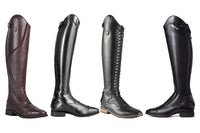Horse riding boots are essential accessories to develop a good work with the horse; precise and comfortable. Apart from aesthetics, you have to look for comfort during the hours of training and even standing on the ground. For this, it is essential to choose quality Horse riding boots, flexible and focused on the practice discipline.
Features Of Horse Riding Boots:
When choosing the proper footwear, there are three aspects to take into account:
The height: you have to choose a horse riding boots size that covers the cane until it reaches very close to the kneecap. A short boot only creates problems with the skirts and does not favor the visual aesthetic. With time and use, the boot will decrease by 1 or 2cm in height.
The width: It is essential that when trying on horse riding boots for the first time, it presses the calf and the leg, making it difficult to close the zipper. After use and time, the leather dilates and adapts to the shape of the leg. Suppose the boot does not fit the portion when the leather widens. In that case, it can do so excessively, resulting in a too-wide shoe that causes chafing due to friction and internal looseness and discomfort, and minor sensitivity when riding. It is ideal that the first week after buying the boot, the training is carried out with the zipper a little low, without closing the joint area completely to adapt gradually.
The foot size: Normally, the ideal boot size will decrease from the number used in a daily shoe since the boots are made to immobilize and fix the limb with the greatest possible comfort. Thanks to this great fit, it will not create creases in the ankle or internal looseness when the leather expands. Remember that the foot is independent of the shaft since the rubber sole does not extend; therefore, it is dilated.
Most manufacturers have more than 3 or 4 cane sizes for each foot. Despite this, on many occasions, an optimal level of fit for the horse riding boots is not reached since each rider has different variations of measurements.
Most manufacturers do not consider extremely wide or thin cufflinks as they cover the most significant sales with standard sizes. In the latest additions of the best brands, elastic has been included on the sides of the zipper to have a 1 or 2 cm margin of elasticity. Despite this, extreme measures continue without a standard-sized boot solution. It is better to look for a customized or made-to-measure boot in these cases.
Equipment recommendation:
For a rider who rides many hours a week, the solution to achieve the degree of precision in the peculiarities of the measurements and the quality of the material is undoubtedly to resort to purchasing personalized or made-to-measure horse riding boots.
This type of footwear is handmade and individual, allowing a perfect adaptation to the leg, foot size, calf width, and leg length. These three parameters guarantee a unique and optimally tailored boot that creates a second-skin feeling.
A rider rides a horse.
If we also add to this that we have to adapt to the horse and the environment in which it develops, we find the ideal conditions to affirm that suitable equipment is essential for horse riding. And if there is an element in our wardrobe that cannot be missing, it is the boots (in addition to suitable pants and a good helmet). Therefore, here are some tips for choosing horse riding boots, depending on the type of activity you do.
What should I take into account for the election?
As general aspects, regardless of the modality you practice, we remind you of the importance of the Horse riding boots gripping your ankle well. This is subjected to impacts and works as a shock absorber for our movements when driven by the horse's own activity. Therefore, a good fit will reduce the possibility of injury.
Likewise, you should know that when the boot is resting on the stirrup, there is a risk that it will get stuck in it. Imagine the risk of being trapped by one leg in the event of a fall! To prevent these situations, it is essential that the front part is not too high or wide. Although docile and good friends of man, horses can be unpredictable: footsteps are frequent, and strong footwear significantly reduces possible damage. And of course, it has to allow mobility. Our feet are an essential way of contacting the horse. Therefore, in addition to being made of solid material, it must be flexible so that it does not limit our activity.
Finally, remind you that the horse riding boots, especially at the beginning of their use, can seem somewhat uncomfortable. Of course, the footwear that we use daily is different from what is necessary for equestrian activities. So don't worry, you will be able to adapt the boot to what you need with the uses.
We also recommend the use of long stockings to avoid possible chafing.
What types of horse riding boots should I avoid wearing?
The first thing is not to use sports shoes, mountain boots, or any other footwear that may seem comfortable is not suitable for equestrian practice.
Likewise, if there is any type of boot that we recommend you not to use, it is made with plastic or rubber. In addition, this material makes the shoes very difficult to put on, especially to take off after practicing sports.
High or low cane horse riding boots
the use of high-top boots (up to below the knees) is recommended. In this way, the leg enjoys more excellent protection, and the possible friction caused by movement does not harm the horse.
The best horse riding boots, depending on the discipline
If rubber horse riding boots are the worst option for equestrian sports and leather is the best material for them, what characteristics should they have depending on the activity?
Choosing the right horse riding boots is essential for horseback riding.
If you usually practice a specific discipline, and you are looking for the best horse riding boots for it, we leave you with the following recommendations:
- Field boots
In this case, the ideal is resistant boots or ankle boots, with a thick sole and insulated from water or humidity.
- Jumping boots
In this modality, staying coordinated with the horse is essential. During the jump, the rider must rise simultaneously as the horse, and for this, they need flexible footwear capable of adapting to the movement without exerting resistance.
- Hunting boots
Ankle boots with gaiters are used. The design is that boots with an unseen zipper (located at the back or inside the side) are used.
- Cross boots
Cross is a sport that integrates the aspects of jumping with the demands of cross country. Hence the need to combine the flexibility of jump shoes with a slightly more resistant sole.
- Raid Boots
Since this is a discipline of speed and resistance, the comfort of the horse and the rider must be taken into account. For this reason, flexible, comfortable, and waterproof ankle horse riding boots are ideal for this modality.
- Dressage boots
In this case, the boot should be somewhat stiffer. Therefore, remember to use it several times until they are fully adapted and comfortable. Also, if you combine riding with work on the ground, remember to wear horse riding boots insulating against moisture, mud, and dirt. For this, the conditions of the sole are fundamental: a thick sole, in which the mud does not adhere and is resistant, is the best option.
If there is an element in our wardrobe that cannot be missing, it is the horse riding boot.






